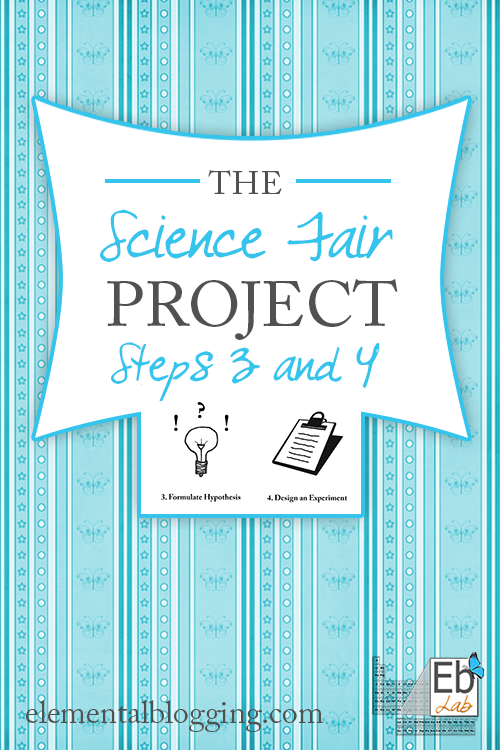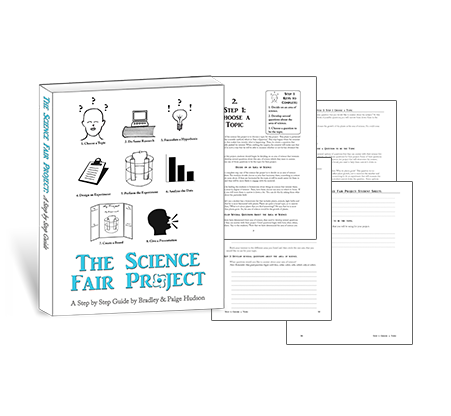
Yesterday we looked at steps one and two of the science fair project. In today’s post, we are going to look closer at step three, in which the students formulate their hypothesis, and step four, where the students design their experiment.
Step 3: Formulate a Hypothesis
The third step of the science fair project is to formulate a hypothesis. This phase is patterned after step three of the scientific method.
This is the point at which the scientist formulates his hypothesis, which means that he makes an educated guess about the answer to his question. He must be able to test the validity of his statement, so that he can measure whether or not he has obtained the answer to his original question. Consequently, a hypothesis is normally simple “if-then” statement that is no more than one sentence long.
So, now the students are ready to make a hypothesis, or educated guess, about the answer to their question. This step will be relatively easy because the students have been well prepared. They need to:
- Review all of their research and their question.
- Formulate an answer to their project’s question.
Once the students have their hypothesis, they are ready to move onto their experiment.
Step 4: Design an Experiment
The fourth step of the science fair project is to design an experiment. This stage is patterned after step four of the scientific method.
In this step the scientist develops and performs an experiment that will test whether his hypothesis is true or false. It is important for the test to be fair, so the scientist will only change one variable at a time and he will always have a control group. Generally he will have more than one sample in each group making his findings much more reliable. The scientist may also find that several experiments are necessary to thoroughly prove whether or not his hypothesis is correct.
At this point in the science fair project, the students have a chosen a topic, done some research and formulated their hypotheses. Now, they are ready to design their experiment. The students may find this step to be a bit challenging, but a well-planned experiment design will yield reliable results.So, it is important that you take the time to walk the students through this process.
Here are the keys you can use:
- Have the students brainstorm for possible ways to test their hypotheses and choose one of those methods for their experiment.
- Have the students determine their variables.
- Have the students plan their experiment around one of those methods of testing.
- Finally, have the students will review their hypotheses to make sure that their experiment design will prove their statement true or false.
Once they have a design in place, the students are ready to perform the test. Tomorrow, we will dig the actually experiment along with analyzing the data.
Have you missed a step? Here’s the links to all of the posts in this series:
- Day 1: Step 1: Choose a Topic & Step 2: Do Some Research
- Day 2: Step 3: Formulate a Hypothesis & Step 4: Design an Experiment
- Day 3: Step 5: Perform the Experiment & Step 6: Analyze the Data
- Day 4: Step 7: Create a Board & Step 8: Give a Presentation
- Day 5: Planning a Homeschool Science Fair (Guest Post by Marci @ The Homeschool Scientist)
 Do you want pages for your students as you guide them through their science fair project? Then check out our step by step guide: The Science Fair Project: A Step by Step Guide!This book is designed to give you the tools you need to guide your students as they complete a science fair project. The first part of the book explains the keys to each step in greater detail than the above post, including a sample project where you will see each of the keys in action. The second half of the book contains sheets for you to use with your students as they proceed through their project.
Do you want pages for your students as you guide them through their science fair project? Then check out our step by step guide: The Science Fair Project: A Step by Step Guide!This book is designed to give you the tools you need to guide your students as they complete a science fair project. The first part of the book explains the keys to each step in greater detail than the above post, including a sample project where you will see each of the keys in action. The second half of the book contains sheets for you to use with your students as they proceed through their project.
 Sign up below to receive weekly tips & tools for homeschool science and we'll send you a FREE copy of
Sign up below to receive weekly tips & tools for homeschool science and we'll send you a FREE copy of 
[…] we looked at steps three & four of the science fair project. In today’s post, we are going to look closer at step five, in which the students will […]